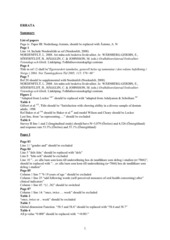| dc.contributor.author | Ekbäck, Gunnar | en_US |
| dc.date.accessioned | 2011-02-16T15:17:40Z | |
| dc.date.available | 2011-02-16T15:17:40Z | |
| dc.date.issued | 2010-12-10 | eng |
| dc.identifier.isbn | 978-82-308-1638-7 (print version) | en_US |
| dc.identifier.uri | https://hdl.handle.net/1956/4510 | |
| dc.description.abstract | Background: Oral health is defined as a broader concept than oral disease, concerning individuals’ optimal functioning, social and psychological wellbeing. Thus, oral disease affects oral health by its functional, psychological and social consequences for the individual. There seems to be a need to assess information about self-reported oral health for such measures to be valid supplements for the conventional clinical measures. Aims: The main objective of this thesis was to contribute to the validation of a single global measure of oral health in the context of younger and older age groups in Sweden and Norway. Specifically, this study assessed the level of oral health satisfaction in younger and older Swedish age groups, examined associations of self reported oral satisfaction with socio demographic, clinical and non-clinical variables across 65-year-olds in Norway and Sweden and examined changes and predictors of changes in oral health satisfaction of a cohort of Swedes as they aged from 50 to 65 yr. Method: The papers of the present thesis are based upon three structured questionnaire surveys. Survey I applies to paper I and was conducted in 2006 involving a census of 19-year-olds attending dental clinics in Örebro and Östergötland. Data were collected by questionnaires and an oral clinical examination. The second survey, (Survey II) is a prospective cohort study initiated in 1992 among all 50-year-olds (born 1942) resident in Örebro and Östergötland. Survey II applies to Papers II and III. Data were collected in 1992, 1997, 2002 and 2007 at ages 50, 55, 60 and 65 yrs, respectively. The survey started as a collaborative project and the counties were chosen by convenience and not with the purpose of being representative for Sweden as a whole. Survey III was conducted in 2007 among a census of the 1942 cohort currently residing in three counties of Norway, Hordaland, Sogn & Fjordane and Nordland. The Norwegian counties were chosen purposively to represent not only the rural and urban parts of the country, but also variability in oral conditions and dental service offered. Survey II and III were based on a similar questionnaire. Results: The aim of Paper I (based on Survey I) was to investigate clinical- and self-perceived oral health indicators among 19-year-olds, using a single global question on oral health and one clinical indicator in terms of DSa. Four subscales (function, knowledge, quality of life and social) were used to identify predictors for self perceived oral health. The results revealed that 87,5% of the 19 yr old participants (n=3,658) was satisfied with their teeth. Females reported more serious problems than males in the social and quality of life dimensions and responders from Östergötland showed better knowledge about oral disease than responders from Örebro (94,4% versus 90,1%). The strongest predictors of satisfaction with oral health were social aspects and quality of life. Statistically significant two-way interactions occurred between county and knowledge and between county and quality of life. In Östergötland knowledge varied systematically with satisfaction, whereas function did not and in Örebro the opposite result was found. Thus, some or good knowledge was more strongly associated with satisfaction in Östergötland than in Örebro, whereas good function was more strongly associated with satisfaction in Örebro. The aim of paper II (based on Survey II and III) was to assess the prevalence of self-reported oral health satisfaction and to examine its relationship with sociodemographic-, behavioural and subjective oral health indicators. In addition, this study examined the extent to which the abovementioned relationships were consistent across Sweden and Norway as reported by 65- year-olds. A total of 76.8% of the Swedish and 76.5% of the Norwegian participants were satisfied with their oral health. Multiple logistic regression analysis revealed that subjects who perceived bad general health, smoked daily, had missing teeth, experienced toothache, had problems with chewing, bad breath and oral impacts were less likely than their counterparts in the opposite group to be satisfied with their oral health status. The corresponding odds ratios ranged from 0.08 (problems chewing) to 0.2 (oral impact). No statistically significant two-way interactions occurred and the model explained 46% of the variance in oral health satisfaction across the countries (45% in Sweden and 47% in Norway). The aim of paper III (based on Survey II) was to assess the stability or change of self-reported satisfaction with teeth in subjects as they age from 50 to 65 and to assess the impacts of socio-demographic, clinical and non-clinical oral health-related factors on tooth satisfaction throughout that period. The result showed that altogether, 63% females and 66% males remained satisfied with their teeth between the ages of 50 and 65. The corresponding figures, with respect to dissatisfaction, were 7% and 6%. GEE models revealed a decline in the odds of being satisfied with advancing age, and this was particularly important in subjects with lower education, tooth loss and in smokers. Remaining all teeth and the absence of chewing problems were the strongest predictors of satisfaction with teeth between ages 50 and 65. Conclusions and implications: A single global question on oral health satisfaction was applicable in terms of having acceptable psychometric properties in the context of younger and older age groups across Sweden and Norway. This supports the notion that to ascertain information about patients’ oral health, both self-reported oral health measures and conventional clinical measures are needed. Such self-reports can be administered in different ways. To ask a single global oral health question (and register the answer) at the time when patients undergo their regular examination is inexpensive and straightforward. The implementation of such a question is a technical matter for the care provider where there are different possibilities to introduce it directly into the medical record or in adhering it in medical history or risk group registration. | en_US |
| dc.language.iso | eng | eng |
| dc.publisher | The University of Bergen | eng |
| dc.relation.haspart | Paper I: Swedish Dental Journal 32(2), Ekbäck, G.; Åstrøm, A. N.; Klock, K.; Ordell, S.; Unell, L., Self-perceived oral health among 19-year-olds in two Swedish counties, pp. 83–93. Reproduced with permission. Published version. | en_US |
| dc.relation.haspart | Paper II: Acta Odontologica Scandinavica 67(4), Ekbäck, G.; Åstrøm, A. N.; Klock, K.; Ordell, S.; Unell, L., Variation in subjective oral health indicators of 65-year-olds in Norway and Sweden, pp. 222-232. Copyright 2009 Informa UK. Full text not available in BORA due to publisher restrictions. | en_US |
| dc.relation.haspart | Paper III: European Journal of Oral Sciences 118(1), Ekbäck, G.; Åstrøm, A. N.; Klock, K.; Ordell, S.; Unell, L., Satisfaction with teeth and life course predictors: a prospective study of a Swedish 1942 birth cohort, pp. 66–74. Copyright 2010 The Authors. Journal compilation 2010 European Journal of Oral Sciences. Full text not available in BORA due to publisher restrictions. The published version is available at: <a href="http://dx.doi.org/10.1111/j.1600-0722.2009.00702.x" target="_blank"> http://dx.doi.org/10.1111/j.1600-0722.2009.00702.x</a> | en_US |
| dc.title | Satisfaction with oral health and associated factors in Sweden and Norway – cross-sectional and longitudinal perspectives | en_US |
| dc.type | Doctoral thesis | |
| dc.rights.holder | Copyright the author. All rights reserved | |
| dc.rights.holder | The author | |
| dc.subject.nsi | VDP::Medical disciplines: 700::Health sciences: 800::Community dentistry: 802 | eng |



